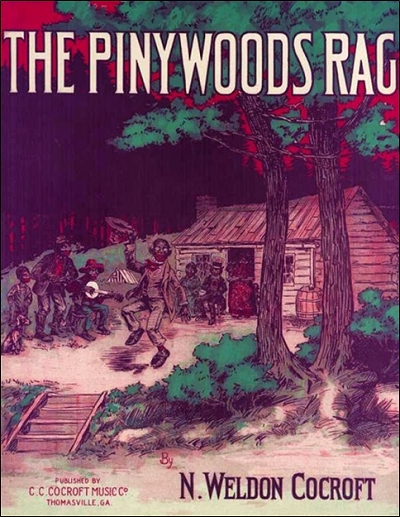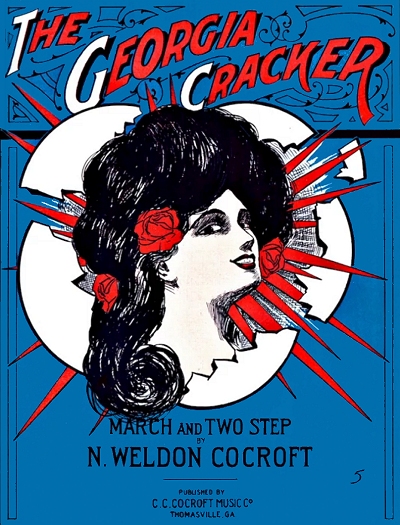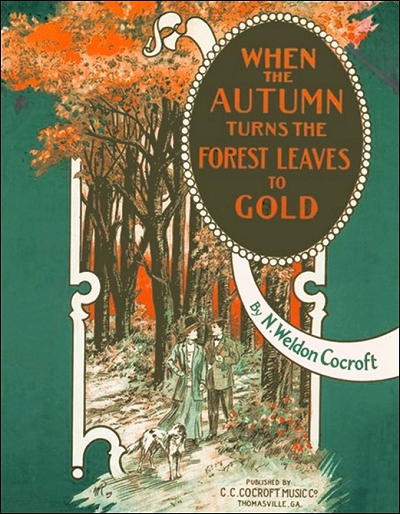Nellie Weldon was born in Quitman in southern Georgia to Richard Aycock Weldon and Virginia Frances Massey. She was the oldest of three daughters, including Jeanivieve Velve "Jenni" (6/1893) and Minnie E. (2/3/1896). As of the 1900 census taken in Quitman, Richard was a traveling salesman, although he also reportedly had owned the Quitman Marble Company there since 1886. In early 1904, Richard moved his family and the company twenty miles west to nearby Thomasville, Georgia, and renamed it as the Thomasville Marble Company. The town warmly welcomed the Weldon family and the business. Among their products were memorial headstones.
Georgia, and renamed it as the Thomasville Marble Company. The town warmly welcomed the Weldon family and the business. Among their products were memorial headstones.
 Georgia, and renamed it as the Thomasville Marble Company. The town warmly welcomed the Weldon family and the business. Among their products were memorial headstones.
Georgia, and renamed it as the Thomasville Marble Company. The town warmly welcomed the Weldon family and the business. Among their products were memorial headstones.Being a family of means, Nellie was sent to Breneau College to obtain a degree in piano and organ performance, graduating in early 1905 at the age of 20. Around that same time Christopher Columbus Cocroft, also a musician and a former vaudevillian, opened a music store in Thomasville. He featured fine pianos and organs, dealing in Steinway, Knabe, Fischer, Hardman, Laffaruge and "other standard pianos." Given their mutual interest in music in a moderate sized town, it was inevitable that they would cross paths and share that interest. They soon did more than that as Nellie and Chris married on April 20, 1905.
Nellie was already musically involved with Thomasville, serving as both the organist and choir director in her church. She was also inspired to write her own material as well, but not liturgical. Since it was a somewhat common practice for music stores of the time to also act as publishers for local talent, when Nellie started writing piano rags her new husband obliged her by arranging to have them printed. The first publications to come from the Cocroft store were The Georgia Cracker, Kute Kids and three other works. It is notable that they were attributed to N. Cocroft, either to mask her gender or possibly her identity due to her deep involvement in her church. Also, since drinking and smoking, two things she highly disapproved of, were often associated with the ragtime crowd, she may have wanted to insulate herself from that association as well. This would later appear to be a trivial issue compared to some of her other activities. Most of the compositions were obviously completed while Nellie was pregnant, as she delivered Charles Christopher on April 1, 1910.
The 1910 enumeration taken in Thomasville showed Christopher, Nellie and Charles hosting Christopher's brother Ben H. Cocroft, who was working as a traveling salesman for the Cocroft Music House. Nellie was listed as a housewife, and was, of course, a new mother. The success of their family enterprise was self-reported in a notice sent to the Music Trade Review, published on March 26, 1910:
 The C. C. Cocroft Music Co., Thomasville, Ga., report an excellent business with their line of pianos, which includes the Chickering, Haines Bros., Foster-Armstrong, McPhail, Henry F. Miller and Laffargue. The company [controls] the agency in southeast Georgia for the various lines and carry on an active campaign in their territory.
The C. C. Cocroft Music Co., Thomasville, Ga., report an excellent business with their line of pianos, which includes the Chickering, Haines Bros., Foster-Armstrong, McPhail, Henry F. Miller and Laffargue. The company [controls] the agency in southeast Georgia for the various lines and carry on an active campaign in their territory. The year 1910 was also the only other one known that Cocroft published music. This included two more pieces from Nellie's pen (copyrighted in 1909, but evidently released in early 1910), including her Pinywoods Rag, written for or in honor of the local luxurious Piney Woods Hotel. According to historian and performer Elliot Adams:
The artwork was commissioned to a company in New York, and when it arrived at the Cocroft offices, there was great consternation at what the artist had provided: a brilliantly colorful drawing to be sure, presumably the artist's imaginative interpretation of southern life, but instead of the modern immense hotel, the cover portrayed a backwoods cabin with stereotypical caricatures of black folks dancing in the yard. Rather than have it redrawn (perhaps because of the expense), Cocroft went ahead and used it. Of course now it is as highly sought after by music collectors for its garish ethnic covers as for its musical and historical value.
Chris also published Cotton States Rag by Annie Ford McKnight and Halifax Rag by H. D. Carter, who was the company's Negro janitor.
Perhaps the hassle involved with preparing the music for publication or the issues with distributing proved to be too much. No more pieces would come from the house of Cocroft and reprints of their publications ceased in 1917. Chris focused largely on instruments, phonographs and records according to ads from that period in the Thomasville Daily Times Enterprise. For the 1920 census taken in Thomasville the Cocroft family was shown hosting six boarders.
Chris focused largely on instruments, phonographs and records according to ads from that period in the Thomasville Daily Times Enterprise. For the 1920 census taken in Thomasville the Cocroft family was shown hosting six boarders.
 Chris focused largely on instruments, phonographs and records according to ads from that period in the Thomasville Daily Times Enterprise. For the 1920 census taken in Thomasville the Cocroft family was shown hosting six boarders.
Chris focused largely on instruments, phonographs and records according to ads from that period in the Thomasville Daily Times Enterprise. For the 1920 census taken in Thomasville the Cocroft family was shown hosting six boarders.Things started to deteriorate in the Cocroft household over the next couple of years, and in April of 1923 Christopher filed for a divorce from Nellie. A rather public jury trial revealed that there were no less than three co-respondents with which Nellie been involved while on various outings to Atlanta, Georgia, or other locations. After the introduction of several intercepted letters, a confession was also evidently rendered in front of witnesses as to her transgressions. The decree was granted on April 19, 1923. It was reversed for a technicality, and then granted for good on October 20, 1924 in the Supreme Court of Georgia, also making case law. Their son remained with his father, who was granted full custody and alimony.
Nellie moved south to Jacksonville, Florida around 1924 even before the dust had settled as per a hearing in April of 1925. For the 1930 census taken in Jacksonville she was listed as a stenographer in a law office. Her son had been helping his father run the music business, changing the company name to CoCroft to make it more unique. However, in 1932 Christopher died, leaving Charles as the head of the company. From 1924 forward the Jacksonville city directories showed Nellie to be a private office secretary or stenographer, but by the late 1940s she no longer listed any occupation. However, the 1950 census showed her still working as a legal secretary. She lived in Jacksonville for the remainder of her exceptionally long life. Nellie died in Jacksonville at the advanced age of 100, and was laid to rest in Laurel Hill Cemetery near her late husband in her earlier home of Thomasville. Her son was still running the store in Thomasville as late as 1994. However, Charles died in 2001.

 Compositions
Compositions